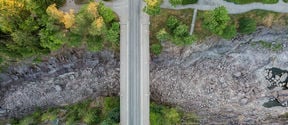Even Finland should be concerned about droughts
Though the risk is still low, recent droughts in Finland have had a serious impact – and they will be more common

One of the best-known stories about Finland is the narrative of the land of thousands of lakes. In actual fact, it’s precisely 187,888 lakes — that’s if you count only those that encompass five acres or more. You could be forgiven for assuming that drought is unlikely to cause serious problems in a country with such an abundance of water. Yet the truth is more complicated.
Doctor of engineering Lauri Ahopelto researched drought risks in Finland in his doctoral thesis. He responded to common beliefs about our water security.
FALSE. These days basically every house has an individual water meter so you would think that Finns would have an accurate idea of how much water we actually use. This is not the case.
Of course, the biggest water users, such as forestry companies, need to hold a water license, so we have some idea of how much water these big players use. Meanwhile, water supply companies can give an approximate indication of how much water households use, as consumers are billed on the basis of the amount of water supplied. But between the two, we are in a grey area — and it’s actually mostly guesswork. For example, we do not have accurate data on how much water is used in agriculture. Similarly, industrial enterprises that are medium-sized in terms of their water consumption are not obligated to report their water usage.
So we have a lot of unknowns about how much water is used in Finland, and this is linked to the 'land of thousands of lakes' narrative. It’s generally seen as not cost-effective, let alone useful, to actually even collect that data. The relative abundance of water also negates any common sense reason for every farmer to start measuring and reporting how much they irrigate. Modelling and surveys can give us some kind of rough estimate of water usage, but collecting accurate data would require new information systems and changes in the law. It’s not seen as a big priority, even though water usage is one piece in the puzzle of drought risks.
In drought-stricken southern Europe and also elsewhere, monitoring water usage is a bigger issue due to both the scarcity of water and the high levels of illegal water intake. In this context it is both more challenging and also more important to get a handle on how much water is actually being used, so that water is distributed fairly and some is left for the environment.

FALSE. Despite Finland's abundant water resources, we are not immune to the severe effects of drought. Droughts over recent decades, especially in 2002–2003 and 2018, have already shown this. However, not only the dry periods, but also the risks they brought with them were very different.
In 2002–2003, the dry spell was a so-called winter drought: it started at the end of summer 2002 and lasted until the beginning of the following summer. This type of dry season had less impact on agriculture, but had serious consequences for water security, including groundwater levels dropping very low.
In contrast, the 2018 drought started in spring and ended in autumn. A summer drought of this kind in the growing season has very severe consequences for agriculture. In both cases, therefore, the drought caused serious damage to water security — even in the land of a thousand lakes.
There’s also the persistent myth that the effects of climate change on our agriculture are largely positive. For example, higher temperatures mean a longer growing season and rainfall is also expected to increase. While this is true, there is a flip side: while the amount of water that falls in a year increases, so too does the risk of drought. This is because climate scenarios predict that precipitation will increase specifically in winter, while during the longer growing season in summer, warming will increase evaporation.

The more and more common extreme weather events brought about by climate change will also increase the risk of drought, especially in summer, which is a risk for agriculture in particular. Water supplies would not necessarily be in such dire straits, as groundwater, for example, responds more slowly to weather changes. Nevertheless, water supply companies should also develop drought management plans.
TRUE. Although climate change will increase drought risks in Finland, there is no particular need for water restrictions. Instead, Finland needs a national drought strategy that, together with measures at local level, will mitigate these increasing drought risks. In addition, a systematic process for managing drought risks needs to be developed, as well as a system of advance warning of dry periods.
But this is also a bit FALSE: prolonged droughts such as the one experienced in 2002–2003 can be very severe for our water security. At that time, water supply companies were in serious trouble, with groundwater levels dropping to very low levels and a lot of wells running dry. And at that time, Finland had to impose restrictions on water use. So this is not entirely out of the question.
Ahopelto’s thesis ”Drought in Water Abundant Finland – Data and Tools for Drought Management” online: https://urn.fi/URN:ISBN:978-952-64-1676-2

Though the risk is still low, recent droughts in Finland have had a serious impact – and they will be more common


